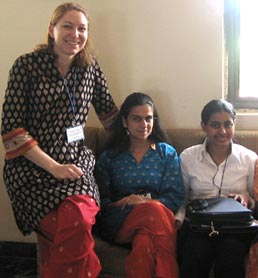El Batán, Mexico
April, 2007
Source:
CIMMYT E-News, vol 4 no.
4 - April 2007
 |
|
Researcher Shirangi Imalka Samararatne (right) of the
Plant Genetic Resources Centre, Sri Lanka, is developing
commercial rice varieties that resist bacterial leaf
blight, one of the crop’s chief menaces, using molecular
markers to pyramid multiple genes for resistance. Here
she is seen with CIMMYT molecular geneticist Marilyn
Warburton (left) and CIMMYT biotechnology consultant,
Claudia Bedoya Salazar. |
The promise of using DNA tools to
characterize heterogeneous populations of tropical crops is
finally being realized, with help from
CIMMYT and partners.
“In the lab where I’m working, we have a number of problems
using SSR markers. I’m happy (now) that my problems are solved.”
The words are those of Shirangi Imalka Samararatne, researcher
in Sri Lanka’s Plant Genetic Resources Centre, after attending
the training workshop “Molecular characterization of inbred
lines and populations in maize” given in New Delhi, India, by
CIMMYT scientists and collaborators during 1-3 April 2007.
Simple sequence repeat (SSR) markers are the tools of choice for
molecular studies in many crop species. They require very little
DNA to use but can also be misread, if the user does not have
the experience to know what to look for, according to CIMMYT
molecular geneticist and workshop lecturer
Marilyn Warburton.
“Moreover, in a population of diverse individuals, you can’t
simply choose a single individual for DNA analysis to
‘fingerprint’ the entire population; you need to sample many
individuals,” she says. “Participants in this course learned to
run SSR markers on individuals and also on bulk samples
containing DNA from 15 individuals, saving time and money in
fingerprinting the population.”
The workshop was hosted by the Indian Agriculture Research
Institute (IARI). It was coordinated by IARI researcher B.M.
Prasanna and sponsored by the Generation Challenge Program (GCP)
of the Consultative Group on International Agricultural Research
(CGIAR), as part of a competitive grant project. The event drew
19 participants from 10 countries in Asia and Africa, with
interest in a broad range of crops. Nine resource persons from 5
countries gave lectures, lab presentations, computer training,
and hands-on practice.
Presentations covered DNA extraction, detection, and analysis
methods, particularly for bulked samples. “The bulked method
allows the analysis of relationships between entire plant
populations and diversity levels within populations,” says
Warburton. “For maize, this means useful DNA characterization of
breeding populations, improved open-pollinated varieties, and
even traditional maize landraces, in a single polymerase chain
reaction (PCR) reaction—something previously not thought
possible.” The PCR technique is used to make large numbers of
copies of a minute sample of DNA for analysis.
One course participant, John Atoyebi, from Nigeria’s National
Centre for Genetic Resources and Biotechnology, hopes to apply
the approach to speed the certification and release of new,
improved maize varieties for farmers in his country. The process
currently involves several years of expensive field testing to
prove a new variety is genetically distinct, uniform, and
stable. “I’m working on the application of molecular tools, such
as DNA fingerprinting, for germplasm identification to avoid
duplication and for Nigeria’s variety release program. The
course has fulfilled my expectations.”
“This course shows how CIMMYT is helping partners gain access to
and master relevant, advanced technology whose applications
ultimately benefit farmers,” says Warburton. “The GCP
competitive grant project, scheduled to wrap up this year, will
show how nearly one thousand maize populations migrated out of
Latin America to the rest of the world, providing information
about which populations should be used to improve maize breeding
material around the world. Course participants who worked on
maize will be able to compare their own breeding material to the
ones in this study and determine which of the thousand could be
incorporated into their program. Further training at CIMMYT is
being looked at by some of the course participants through
further funding from the GCP”. |
|